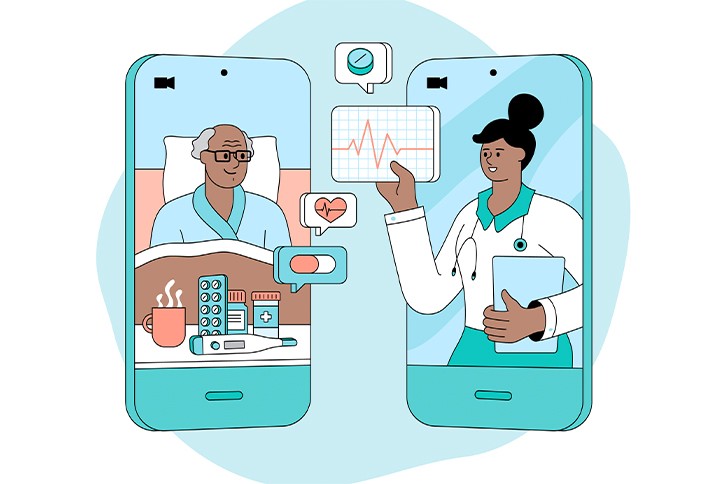Embracing Telemedicine: Changing Medical Care Delivery for a Modern Globe
As we navigate an era identified by rapid digitalization and progressing client demands, the assimilation of telemedicine into typical medical care methods presents an engaging recommendation. In exploring the effects and intricacies of welcoming telemedicine, a nuanced understanding of its diverse impact on health care delivery in the contemporary globe comes to be imperative.
The Development of Telemedicine
Telemedicine has actually gone through substantial development over the previous few years, changing the landscape of healthcare delivery. Originally conceived to link the gap between doctor and individuals in remote locations, telemedicine has now increased its reach to offer a variety of medical solutions via technical improvements.
In the onset, telemedicine primarily entailed appointments by means of telephone or video conferencing. Nonetheless, with the spreading of digital devices and systems, healthcare specialists can currently remotely check crucial signs, conduct digital assessments, and even execute specific clinical procedures. This shift in the direction of more detailed virtual treatment has actually transformed the means medical care is supplied, making it extra available and practical for clients.
Furthermore, the assimilation of electronic wellness records (EHRs) and telemedicine has boosted sychronisation amongst health care teams, leading to a lot more effective and collaborative person care. Telemedicine reviews. With the continuous developments in expert system and remote monitoring devices, telemedicine is poised to continue advancing, providing cutting-edge options to improve health care end results globally

Benefits of Telemedicine Fostering
As the usage of telemedicine has actually broadened to incorporate a broader range of medical solutions and technological abilities, the advantages of its adoption in contemporary medical care delivery have come to be increasingly noticeable. One of the main benefits of telemedicine is enhanced access to health care solutions, specifically for individuals in underserved or remote locations. People can now consult with doctor without the requirement for prolonged travel, decreasing both time and expense obstacles. In addition, telemedicine enhances benefit for individuals by permitting them to schedule visits sometimes that match their timetables, advertising better adherence to therapy strategies.
Additionally, telemedicine can cause enhanced wellness end results via boosted treatment sychronisation. With the ability to easily team up and share clinical records with specialists, medical care companies can use more prompt and detailed treatment. This streamlined strategy can cause faster diagnoses, reduced hospital admissions, and far better administration of persistent conditions. Furthermore, telemedicine can aid minimize strain on typical healthcare systems by decreasing congestion in hospitals and clinics, ultimately improving general efficiency and person fulfillment.
Overcoming Telemedicine Challenges
Attending to the barriers integral in integrating telemedicine into existing health care systems provides an essential yet surmountable challenge for healthcare suppliers worldwide. One major obstacle is the resistance to transform amongst both medical care specialists and people. Convincing conventional doctor to take on telemedicine calls for thorough training programs and continual assistance to ensure seamless integration. Patients might be reluctant to accept virtual consultations due to concerns about the top quality of treatment or a lack of familiarity with the technology.
Additionally, governing obstacles and compensation restrictions present substantial obstacles to the extensive execution of telemedicine. Diverse state and nation guidelines regarding telemedicine techniques create a complicated environment for carriers to navigate. Repayment policies that do not effectively compensate for telemedicine solutions can deter health care companies from purchasing this ingenious strategy to care delivery.

Enhancing Patient-Provider Interaction
Browsing the landscape of telemedicine difficulties brightens the crucial demand for enhancing patient-provider communication in modern-day healthcare shipment systems - Telemedicine reviews. Reliable communication lies at the heart of top quality healthcare arrangement, and in the world of telemedicine, where physical signs may be limited, clear and understanding communication ends up being much more vital
Enhancing patient-provider interaction in telemedicine includes different strategies. Providing clear guidelines, establishing reasonable expectations, and making certain open lines of interaction for follow-up inquiries can enhance the total individual experience in telemedicine.
Future Trends in Telemedicine
Expecting the evolution of telemedicine, innovations in innovation and healthcare distribution look at here systems are leading the way for cutting-edge techniques to client treatment. One of the future trends in telemedicine is the combination of synthetic knowledge (AI) and equipment understanding algorithms to boost diagnostic capabilities. AI can examine vast quantities of client information rapidly, assisting doctor in making extra accurate medical diagnoses and treatment choices. Additionally, using digital truth (VIRTUAL REALITY) and enhanced fact (AR) in telemedicine is gaining energy. These technologies can produce immersive experiences for both carriers and clients, promoting virtual examinations and clinical training simulations.
By leveraging telemedicine, medical care providers can get to people in remote areas, enhancing access to quality care. These innovations in telemedicine hold wonderful assurance for her comment is here changing health care delivery and boosting person results in the future.
Final Thought
In conclusion, telemedicine has actually changed health care delivery by boosting accessibility to care, enhancing efficiency, and boosting client outcomes. Regardless of difficulties, the benefits of telemedicine fostering are clear, paving the means for much better patient-provider communication and future innovations in health care. As technology proceeds to develop, telemedicine will certainly play a vital role in changing healthcare distribution for a contemporary globe.

Expecting the evolution of telemedicine, innovations in innovation and healthcare distribution systems are paving the means for discover here ingenious approaches to individual care. These innovations in telemedicine hold excellent guarantee for changing healthcare distribution and improving patient end results in the future.
In final thought, telemedicine has transformed medical care delivery by improving accessibility to care, enhancing performance, and enhancing individual outcomes.